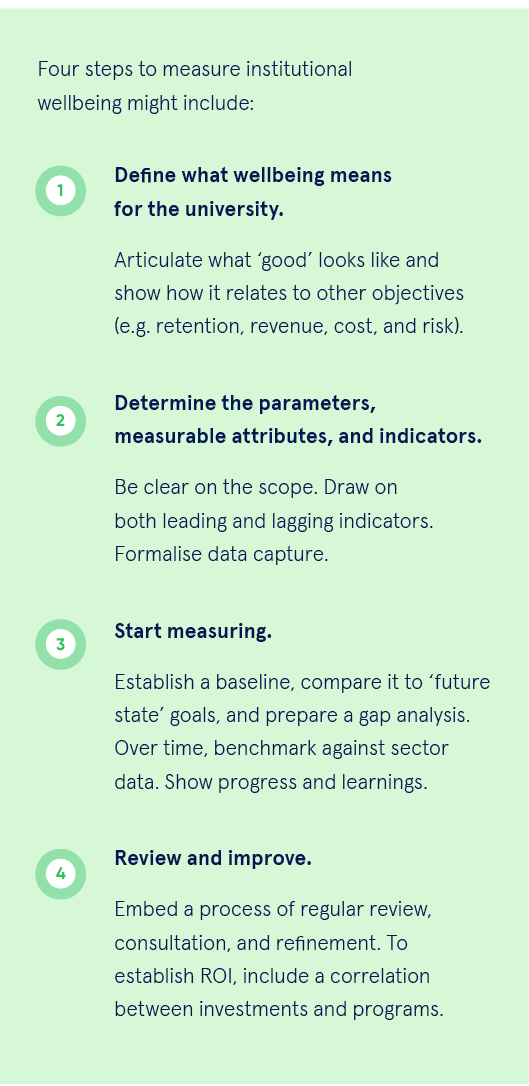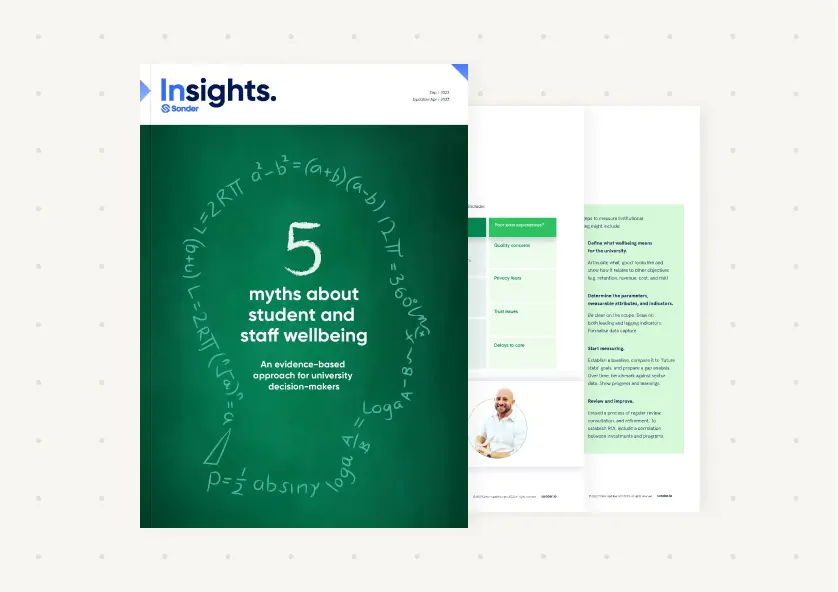Wellbeing advocates often struggle to secure appropriate funding for their university wellbeing initiatives. Many times this is because their business cases focus on qualitative rather than quantitative data. This presents a mismatch with budget holders who prefer quantifiable metrics – to satisfy their due diligence, allay their sense of risk, and promote accountability of results.
What the evidence says
The good news is that there is widespread acceptance that wellbeing can be measured, albeit a lack of consensus# on a common measurement standard.
There have been at least 30 formal measures of wellbeing developed over the past 50 years, using different definitions and applied to the organisational context. It is not necessary to adopt an existing formal measure, but a university may find it useful to review existing measures when articulating the metrics that will be relevant to their specific institution.
References: Download report to access full reference list.

How to measure university wellbeing
Unlike sales and expense figures, wellbeing metrics do not fit naturally on a balance sheet. Similar to staff performance metrics, wellbeing metrics need work done behind the scenes to define what is being measured, when, how, and why. This upfront effort, together with a concern about choosing the wrong metrics, can deter universities from starting their journey.
However, it’s important to remember that wellbeing metrics will evolve over time, based on: a maturing definition of wellbeing; best practices in the sector; and each institution’s learnings. The necessity to start, learn, and pivot should trump the requirement for perfectionism at commencement.

Wellbeing metrics for universities
The measurement of student and staff wellbeing typically involves a combination of leading and lagging indicators, as per the examples that follow:
Leading indicators
Leading indicators (“inputs”) help predict future outcomes and events. They “look forward through the windshield at the road ahead”. Examples include:
Examples include:
- High-level support
- Leadership buy-in (as rated by students and staff)
- Leaders ‘walk the talk’ about healthy university practices
- Leaders talk about their mental health and wellbeing
- Leaders encourage discussion of student and staff wellbeing
- Leaders commit to best practice in wellbeing
- Funding
- Amount budgeted for student and staff wellbeing
- Staff time allocated to wellbeing management
- Policies and processes (existence and quality)
- Safety and wellbeing policies
- Flexible and remote work policies
- Leave policies
- Diversity, equity, and inclusion policies
- Bullying and harassment policies
- Clear and effective change management processes
- Regular insights gathered
- Formal feedback loops in place
- Leadership buy-in (as rated by students and staff)
- Scope
- Physical health and safety
- Psychological health and safety
- Including the management of psychosocial risks
- Job design
- The level of personal control, autonomy, and decision-making
- The level of colleague, team, and management support for tasks assigned
- Programs and initiatives
- Professional development opportunities
- Wellbeing programs and initiatives. Examples might include:
- Gym benefits
- Safety services
- Social activities
- Sleep programs
- Health programs
- Financial support
- Exercise programs
- Health assessments
- Telehealth programs
- Mental health support
- Career support programs
- Health insurance or benefits
- Onsite or offsite vaccinations
- Awareness
- Amount of visible health-promoting collateral
- Number and reach of wellbeing information sessions
- Number of ‘speak up’ programs and champions
- Portion aware of the different wellbeing initiatives
- Portion who understand each wellbeing initiative
- Training
- First aid (and mental health first aid) training
- Resilience training
- Compassion training
- Workplace Health and Safety (WHS) training
- Diversity, equity, and inclusion training
- Participation and engagement
- Reach of programs and initiatives
- Participation and uptake rates
- Engagement with wellbeing resources
- Health behaviours (e.g. the number who are meeting the daily physical activity and alcohol consumption recommendations, as well as the number who are smoke-free)
- Satisfaction
- Focus groups
- Satisfaction and engagement surveys
- Employee Net Promoter Score (eNPS)
- QILT Student Experience Survey (SES)
Disclaimer: List is suggestive, not exhaustive.
References: Download report to access full reference list.

Lagging indicators
Lagging indicators (“outputs”) show tangible results. They “look backwards through the rear window at the road already travelled”.
Examples include:
- Health
- Prevalence of health conditions
- Student support program usage
- Staff support program (e.g. EAP) usage
- Number of referrals to other third parties for help
- Claims and premiums
- Health insurance claims
- Workers’ compensation claims
- Health care spend (including premiums)
- Work time
- Annual leave usage rates
- Sickness and absenteeism rates
- Lost time injury frequency rates (LTIFR)
- Lost work days to institutional factors
- Return to work rates
- Legal and compliance
- Recommended actions from WHS audits
- Workplace investigations
- Workplace litigations
- Attrition
- Peer reviews and 360-degree feedback
- Voluntary staff attrition rates
- Early student departure rates
- Exit survey information
Disclaimer: List is suggestive, not exhaustive.
References: Download report to access full reference list.

The dilemma of choice
Over the years, wellbeing offerings for students and staff have evolved into a smorgasbord of choice. Whilst this represents positive progress, it has also created:
- A complex landscape for students and staff to navigate
- Unless they have a single point of entry to their university’s wellbeing service offerings; and
- A daunting requirement for wellbeing leaders to provide whole-of-business insights
- Unless their wellbeing offerings are integrated and actively capturing meaningful data on all of their initiatives.
Next steps
As evidenced above, the wellbeing of students and staff can be measured, which is great news for wellbeing advocates who struggle to secure appropriate funding for their wellbeing initiatives due to lack of qualitative and/or quantitative data.
Similar to many other strategies and programs, the secret to impactful measurement is to take action now and evolve – not wait for next semester, next year, or for the stars to align.
Want to learn more?
To read the other four myths about student and staff wellbeing, we invite you to download our evidence-based report, 5 myths about student and staff wellbeing.
For more information about how Sonder can help you rethink your university’s student and staff wellbeing strategies, we invite you to contact us here.

About Sonder
Sonder is a technology company that helps organisations improve the wellbeing of their people so they perform at their best. Our mobile app provides immediate, 24/7 support from a team of safety, medical, and mental health professionals – plus onsite help for time-sensitive scenarios. Accredited by the Australian Council on Healthcare Standards (ACHS), our platform gives leaders the insights they need to act on tomorrow’s wellbeing challenges today.



